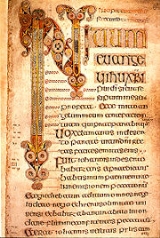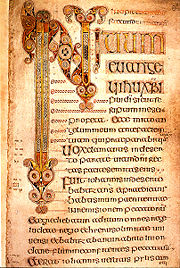
Insular script
Encyclopedia

Middle Ages
The Middle Ages is a periodization of European history from the 5th century to the 15th century. The Middle Ages follows the fall of the Western Roman Empire in 476 and precedes the Early Modern Era. It is the middle period of a three-period division of Western history: Classic, Medieval and Modern...
script system originally used in Ireland
Ireland
Ireland is an island to the northwest of continental Europe. It is the third-largest island in Europe and the twentieth-largest island on Earth...
, then Great Britain
Great Britain
Great Britain or Britain is an island situated to the northwest of Continental Europe. It is the ninth largest island in the world, and the largest European island, as well as the largest of the British Isles...
, that spread to continental Europe
Continental Europe
Continental Europe, also referred to as mainland Europe or simply the Continent, is the continent of Europe, explicitly excluding European islands....
under the influence of Celtic Christianity
Celtic Christianity
Celtic Christianity or Insular Christianity refers broadly to certain features of Christianity that were common, or held to be common, across the Celtic-speaking world during the Early Middle Ages...
. Irish missionaries also took the script to continental Europe, where they founded monasteries such as Bobbio
Bobbio
Bobbio is a small town and commune in the province of Piacenza in Emilia-Romagna, northern Italy. It is located in the Trebbia River valley southwest of the town Piacenza. There is also an abbey and a diocese of the same name...
. The scripts were also used in monasteries influenced by English missionaries like Fulda
Fulda
Fulda is a city in Hesse, Germany; it is located on the river Fulda and is the administrative seat of the Fulda district .- Early Middle Ages :...
. It is associated with Insular art
Insular art
Insular art, also known as Hiberno-Saxon art, is the style of art produced in the post-Roman history of Ireland and Great Britain. The term derives from insula, the Latin term for "island"; in this period Britain and Ireland shared a largely common style different from that of the rest of Europe...
, of which most surviving examples are illuminated manuscript
Illuminated manuscript
An illuminated manuscript is a manuscript in which the text is supplemented by the addition of decoration, such as decorated initials, borders and miniature illustrations...
s. It greatly influenced Irish orthography
Irish orthography
Irish orthography has evolved over many centuries, since Old Irish was first written down in the Latin alphabet in about the 6th century AD. Prior to that, Primitive Irish was written in Ogham...
and modern Gaelic script
Gaelic script
Gaelic type, sometimes called Irish character, Irish type, or Gaelic script, is a family of insular typefaces devised for printing Irish and used between the 16th and 20th centuries. Sometimes all Gaelic typefaces are called Celtic or uncial, though most Gaelic types are not uncials...
s in handwriting and typeface
Typeface
In typography, a typeface is the artistic representation or interpretation of characters; it is the way the type looks. Each type is designed and there are thousands of different typefaces in existence, with new ones being developed constantly....
s.
Origin
The script developed in Ireland in the 7th century and was used as late as the 19th century, though its most flourishing period fell between 600 and 850. It was closely related to the uncialUncial
Uncial is a majuscule script commonly used from the 3rd to 8th centuries AD by Latin and Greek scribes. Uncial letters are written in either Greek, Latin, or Gothic.-Development:...
and half-uncial scripts, its immediate influences; the highest grade of Insular script is the majuscule Insular half-uncial, which is closely derived from Continental half-uncial script.
Appearance
Works written in Insular scripts commonly use large initial letters surrounded by red ink dots (although this is also true of other scripts written in Ireland and England). Letters following a large initial at the start of a paragraph or section often gradually diminish in size as they are written across a line or a page, until the normal size is reached, which is called a "diminuendo" effect, and is a distinctive insular innovation, which later influenced Continental illumination style. Letters with ascenders (b, d, h, l, etc.) are written with triangular or wedge-shaped tops. The bows of letters such as b, d, p, and q are very wide. The script uses many ligaturesLigature (typography)
In writing and typography, a ligature occurs where two or more graphemes are joined as a single glyph. Ligatures usually replace consecutive characters sharing common components and are part of a more general class of glyphs called "contextual forms", where the specific shape of a letter depends on...
and has many unique scribal abbreviation
Scribal abbreviation
Scribal abbreviations are the abbreviations used by ancient and mediæval scribes writing in Latin and, later, in Greek and Old Norse...
s, along with many borrowings from Tironian notes
Tironian notes
Tironian notes is a system of shorthand said to have been invented by Cicero's scribe Marcus Tullius Tiro. Tiro's system consisted of about 4,000 signs, somewhat extended in classical times to 5,000 signs. In the European Medieval period, Tironian notes were taught in monasteries and the system...
.
Insular script was spread to England by the Hiberno-Scottish mission
Hiberno-Scottish mission
The Hiberno-Scottish mission was a mission led by Irish and Scottish monks which spread Christianity and established monasteries in Great Britain and continental Europe during the Middle Ages...
; previously, uncial script had been brought to England by Augustine of Canterbury
Augustine of Canterbury
Augustine of Canterbury was a Benedictine monk who became the first Archbishop of Canterbury in the year 597...
. The influences of both scripts produced the Insular script system.
Within this system, the scholar Julian Brown identified five grades:
- Insular half-uncial, or "Irish majuscle", a majuscule script influenced by
- Insular Hybrid minuscule
- Insular Set
- Insular Cursive
- Insular Current.
Brown has also postulated two Phase of development for this script, Phase II being mainly influenced by Roman Uncial examples, developed at Wearmouth-Jarrow and typified by the Lindisfarne Gospels
Lindisfarne Gospels
The Lindisfarne Gospels is an illuminated Latin manuscript of the gospels of Matthew, Mark, Luke and John in the British Library...
.
Usage
The script was used not only for LatinLatin
Latin is an Italic language originally spoken in Latium and Ancient Rome. It, along with most European languages, is a descendant of the ancient Proto-Indo-European language. Although it is considered a dead language, a number of scholars and members of the Christian clergy speak it fluently, and...
religious books, but also for every other kind of book, including vernacular works. Examples include the Book of Kells
Book of Kells
The Book of Kells is an illuminated manuscript Gospel book in Latin, containing the four Gospels of the New Testament together with various prefatory texts and tables. It was created by Celtic monks ca. 800 or slightly earlier...
, the Cathach of St. Columba
Cathach of St. Columba
The Cathach of St. Columba is an late 6th century Irish Psalter.It is traditionally associated with St. Columba , and was identified as the copy made by him of a book loaned to him by St. Finnian, and which led to the Battle of Cúl Dreimhne in 561...
, the Ambrosiana Orosius, the Durham Cathedral Library A. II. 10. Gospel Book Fragment, the Book of Durrow
Book of Durrow
The Book of Durrow is a 7th-century illuminated manuscript gospel book in the Insular style. It was probably created between 650 and 700, in Northumbria in Northern England, where Lindisfarne or Durham would be the likely candidates, or on the island of Iona in the Scottish Inner Hebrides...
the Durham Gospels
Durham Gospels
The Durham Gospels is a very incomplete late 7th century insular Gospel Book, now kept in the Durham Cathedral Library . A single folio of this manuscript is now in Magdalene College, Cambridge . Only two of the fully decorated pages survive: a Crucifixion and the initial to John, and both of...
, the Echternach Gospels
Echternach Gospels
The Echternach Gospels is an 8th-century insular Gospel Book from the library of the monastery of Echternach, Luxembourg. It is now in the Bibliothèque Nationale in Paris . The manuscript was written by the same scribe that wrote the Durham Gospels.-References:* De Hamel, Christopher. A History...
, the Lindisfarne Gospels
Lindisfarne Gospels
The Lindisfarne Gospels is an illuminated Latin manuscript of the gospels of Matthew, Mark, Luke and John in the British Library...
, the Lichfield Gospels
Lichfield Gospels
The Lichfield Gospels is an eighth century Insular Gospel Book housed in Lichfield Cathedral. There are 236 surviving folios, eight of which are illuminated. Another four contain framed text...
, the St. Gall Gospel Book
St. Gall Gospel Book
The St. Gall Gospel Book is a medieval insular Gospel Book. It is now in the Abbey of St. Gall cathedral library . It has 134 folios. Amongst its illustrations are a Crucifixion, a Last Judgement, a Chi Rho monogram page, a carpet page, and Evangelist portraits....
, and the Book of Armagh
Book of Armagh
The Book of Armagh or Codex Ardmachanus , also known as the Canon of Patrick and the Liber Armachanus, is a 9th-century Irish manuscript written mainly in Latin. It is held by the Library of Trinity College, Dublin...
.
Insular script was influential in the development of Carolingian minuscule
Carolingian minuscule
Carolingian or Caroline minuscule is a script developed as a writing standard in Europe so that the Roman alphabet could be easily recognized by the literate class from one region to another. It was used in Charlemagne's empire between approximately 800 and 1200...
in the scriptoria of the Carolingian empire.
In Ireland, Insular script was superseded in circa 850 by Late-Celtic script; in England, it was followed by a form of Caroline minuscule.
The "Tironian
Tironian notes
Tironian notes is a system of shorthand said to have been invented by Cicero's scribe Marcus Tullius Tiro. Tiro's system consisted of about 4,000 signs, somewhat extended in classical times to 5,000 signs. In the European Medieval period, Tironian notes were taught in monasteries and the system...
et" ⁊ (identical in meaning to the Roman ampersand
Ampersand
An ampersand is a logogram representing the conjunction word "and". The symbol is a ligature of the letters in et, Latin for "and".-Etymology:...
, &) was in widespread use in the script (meaning ond 'and' in Old English and agus 'and' in Irish) and is occasionally continued in modern Gaelic typefaces derived from insular script.
See also
- Carolingian minusculeCarolingian minusculeCarolingian or Caroline minuscule is a script developed as a writing standard in Europe so that the Roman alphabet could be easily recognized by the literate class from one region to another. It was used in Charlemagne's empire between approximately 800 and 1200...
- Gaelic type
- Hiberno-Saxon art
- Insular GInsular GInsular G is a form of the letter g somewhat resembling a tailed z or lowercase delta, used in Britain and Ireland. It was first used by the Irish, passed into Old English, and developed into the Middle English letter yogh...
- Irish orthographyIrish orthographyIrish orthography has evolved over many centuries, since Old Irish was first written down in the Latin alphabet in about the 6th century AD. Prior to that, Primitive Irish was written in Ogham...
- List of Hiberno-Saxon illustrated manuscripts
External links
- Pfeffer Mediæval An insular minuscule as a UnicodeUnicodeUnicode is a computing industry standard for the consistent encoding, representation and handling of text expressed in most of the world's writing systems...
font (strictly speaking, a Carolingian minuscule with a set of insular variants) - Wiglaf the Writer - Insular Minuscule Examples of insular minuscule handwritten documents.

